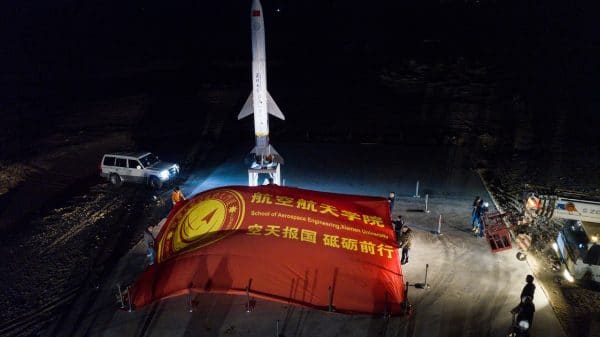A Chinese university just tested a new hypersonic rocket this week, which leads analysts to believe that it could be the prototype for a new weapons system, and the U.S. has no defense against it.
The School of Aeronautics and Astronautics at China’s Xiamen University developed the rocket, dubbed “Jia Geng No. 1” and carried out its launch in the early morning hours on Tuesday, according to the university’s report.
Xiamen University Aerospace Academy with Beijing Lingkong Tianxing Technology Co., Ltd. successfully launched and recovered the reusable winged suborbital JiaGeng-1 technology tester rocket. (max alt 26.2Km)
ℹ:https://t.co/kxtCxLBAla pic.twitter.com/zJE3sB6QJF
— LaunchStuff (@LaunchStuff) April 23, 2019
The university referred to the rocket as “a new type of winged recyclable rocket” as part of the their “Double First Class” project. The test served to “verify the aerodynamic performance of the double-spaced wave precursor layout.”
Xiamen is the first university in the world to develop and launch a hypersonic aircraft, having originally created the design in 2008.
Hypersonic weapons are capable of achieving as high as Mach 15 speeds — 15,000 miles per hour. The Jia Geng rocket achieved a speed of 11,509 miles per hour, according to The Sun.

Xiamen University’s “Jia Geng No. 1” hypersonic rocket, launched for the first time April 23, 2019. (Xiamen University/Released)
Hypersonic weapons from China and Russia are identified by U.S. agencies as one of the most significant emerging weapons threats.
A Government Accountability Office report from Dec. 2018 warned, “China and Russia are pursuing hypersonic weapons because their speed, altitude, and maneuverability may defeat most missile defense systems, and they may be used to improve long-range conventional and nuclear strike capabilities. There are no existing countermeasures
Zhu Chengxiang, an assistant professor at the university’s School of Aerospace Engineering, said the design is also referred to as “the double waverider,” which could be a reference to the Boeing X-51 Waverider, a hypersonic passenger plane currently in development.
While the X-51 travels on a layer of hot gas called a “shock wave,” the Jia Geng No. 1 travels on two layers of those shock waves – “one under its belly and the other in the air-inlet duct for its ramjet engine,” South China Morning Post explained.

Xiamen University’s “Jia Geng No. 1” hypersonic rocket, launched for the first time April 23, 2019. (Xiamen University/Released)
With a length of 8.7 meters (28.5 feet) and a wingspan of 2.5 meters (8.2 feet), the rocket’s takeoff weight is 3,700 kilograms (8,157 pounds).
The university said the test marked significant progress in reusable rocket technology development by testing the rocket’s “overall recycling, synchronous verification of a number of key technologies including ground wireless test and control, umbrella drop recovery system, low-cost electrical systems,” and more.
The rocket is named for Xiamen University founder, Chen Jiageng, who is also a prominent businessman in China.
Leaked pics of China 11,509-mph HYPERSONIC rocket… https://t.co/mFSVj4Lbqh
— Drudge Report Feed (@drudgefeed) April 25, 2019
China has surged ahead of the U.S. in terms of missile development because they were not bound by the 1987 Intermediate-Range Nuclear Forces treaty between the U.S. and Russia, which prohibited the testing of ground-launched missiles with ranges from 310 miles to 3,420 miles.
Most of China’s missiles fall within the category of missiles that the U.S. was unable to test for more than 30 years.
In Feb. 2018, U.S. Navy Admiral Harry Harris, who has repeatedly warned Congress in recent years of China’s growing military developments, said “I think that China’s hypersonic weapons development outpaces ours now, and I think we are falling behind,” Fox News reported.
“China’s intent is crystal clear. We ignore it at our peril,” Harris said. “China’s impressive military buildup could soon challenge the United States across almost every domain.”



